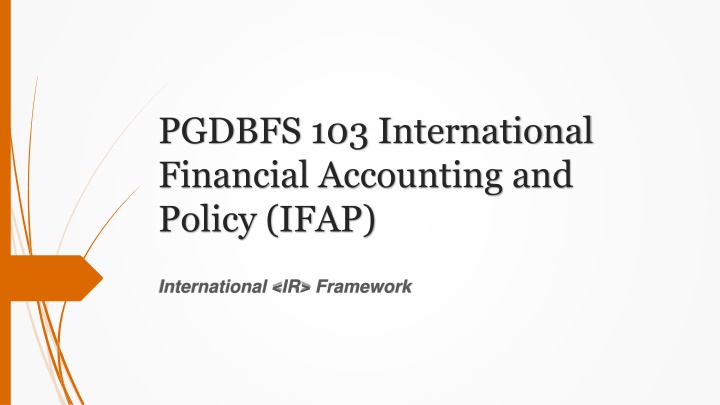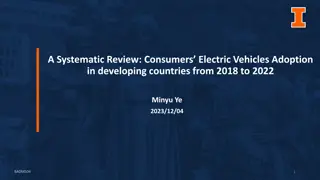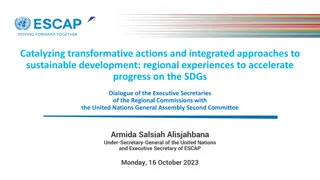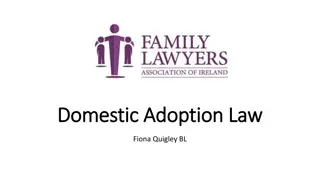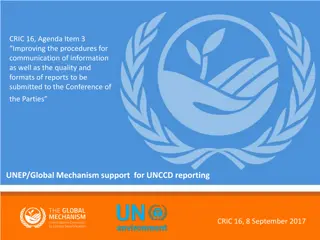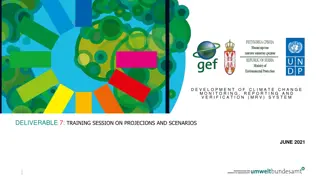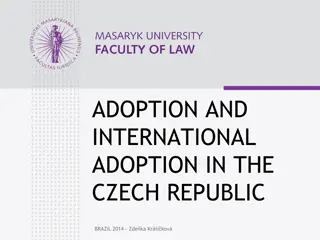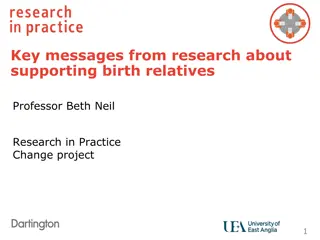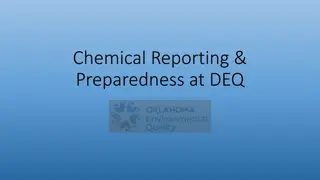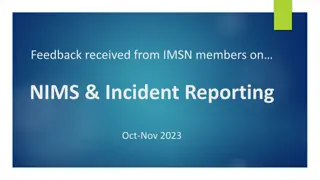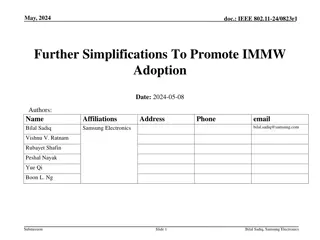Accelerating Adoption of Integrated Reporting with the International Integrated Reporting Framework
The International Integrated Reporting Framework aims to enhance corporate reporting by focusing on factors that influence an organization's value creation over time. It promotes integrated thinking, accountability, and stewardship for various capitals to support decision-making and actions. The International Integrated Reporting Council (IIRC) plays a key role in advancing the evolution of corporate reporting worldwide. Key concepts such as strategic focus, connectivity of information, and comprehensive materiality are central to the framework.
Download Presentation

Please find below an Image/Link to download the presentation.
The content on the website is provided AS IS for your information and personal use only. It may not be sold, licensed, or shared on other websites without obtaining consent from the author.If you encounter any issues during the download, it is possible that the publisher has removed the file from their server.
You are allowed to download the files provided on this website for personal or commercial use, subject to the condition that they are used lawfully. All files are the property of their respective owners.
The content on the website is provided AS IS for your information and personal use only. It may not be sold, licensed, or shared on other websites without obtaining consent from the author.
E N D
Presentation Transcript
PGDBFS 103 International Financial Accounting and Policy (IFAP) International <IR> Framework
International <IR> Framework The International Integrated Reporting Framework (January 2021) is used to accelerate the adoption of integrated reporting across the world. Integrated reporting aims to: Improve the quality of information available to providers of financial capital to enable a more efficient and productive allocation of capital Promote a more cohesive and efficient approach to corporate reporting that draws on different reporting strands and communicates the full range of factors that materially affect the ability of an organization to create value over time Enhance accountability and stewardship for the broad base of capitals (financial, manufactured, intellectual, human, social and relationship, and natural) and promote understanding of their independencies Support integrated thinking, decision-making and actions that focus on the creation of value over the short, medium and long term.
International <IR> Framework The International Integrated Reporting Council (IIRC) is a global coalition of regulators, investors, companies, standard setters, the accounting profession, academia and NGOs. The coalition promotes communication about value creation as the next step in the evolution of corporate reporting. The IIRC published revisions to the <IR> Framework in January 2021 to enable more decision-useful reporting. The revisions, the first since the <IR> Framework was originally published in 2013, are the result of extensive market consultation with 1,470 individuals in 55 jurisdictions. The consultation demonstrated that the conceptual thinking and principles of the <IR> Framework remain fit for purpose and robust.
Structure of The IIRC The IIRC embodies the shared, common interest of a global coalition of parties in the adoption of Integrated Reporting on an international basis as a means to improve communication about value creation, advance the evolution of corporate reporting, and make a lasting contribution to financial stability and sustainable development. The coalition comprises entities drawn from broad global communities, including business and other reporting entities; providers of financial capital; policy makers, regulators and exchanges; the accounting profession; reporting framework developers and standard setters; civil society; and academia.
Key concepts of <IR> Guiding Principles Seven Guiding Principles underpin the preparation and presentation of an integrated report, informing the content of the report and how information is presented: . Strategic focus and future orientation. An integrated report should provide insight into the organization s strategy, and how it relates to the organization s ability to create value in the short, medium and long term, and to its use of and effects on the capitals Connectivity of information. An integrated report should show a holistic picture of the combination, interrelatedness and dependencies between the factors that affect the organization s ability to create value over time Stakeholder relationships. An integrated report should provide insight into the nature and quality of the organization s relationships with its key stakeholders, including how and to what extent the organization understands, takes into account and responds to their legitimate needs and interests Materiality. An integrated report should disclose information about matters that substantively affect the organization s ability to create value over the short, medium and long term Conciseness. An integrated report should be concise Reliability and completeness. An integrated report should include all material matters, both positive and negative, in a balanced way and without material error Consistency and comparability. The information in an integrated report should be presented: (a) on a basis that is consistent over time; and (b) in a way that enables comparison with other organizations to the extent it is material to the organization s own ability to create value over time.
Key concepts of <IR> Content Elements An integrated report includes eight Content Elements that are fundamentally linked to each other and are not mutually exclusive: Organizational overview and external environment. What does the organization do and what are the circumstances under which it operates? Governance. How does the organization s governance structure support its ability to create value in the short, medium and long term? Business model. What is the organization s business model? Risks and opportunities. What are the specific risks and opportunities that affect the organization s ability to create value over the short, medium and long term, and how is the organization dealing with them? Strategy and resource allocation. Where does the organization want to go and how does it intend to get there? Performance. To what extent has the organization achieved its strategic objectives for the period and what are its outcomes in terms of effects on the capitals? Outlook. What challenges and uncertainties is the organization likely to encounter in pursuing its strategy, and what are the potential implications for its business model and future performance? Basis of presentation. How does the organization determine what matters to include in the integrated report and how are such matters quantified or evaluated?
Key concepts of <IR> Fundamental Concepts The Fundamental Concepts underpin and reinforce the requirements and guidance in the <IR> Framework. Organizational overview and external environment. What does the organization do and what are the circumstances under which it operates? Value creation, preservation or erosion for the organization and for others The capitals Financial capital Manufactured capital Intellectual capital Human capital Social and relationship capital Natural capital Process through which value is created, preserved or eroded
<IR> in Sri Lanka Under the patronage, guidance and support of the IIRC, the Council of CA Sri Lanka has formed a committee titled the Integrated Reporting Council on 05 July 2016, with a view of promoting Integrated Reporting in Sri Lanka and enabling corporates and others interested to share knowledge on matters relating to the content, context and implementation.
Integrated Report vs Sustainability report The main differences between the two report forms, in terms of purpose, audience and scope are as summarized below. Integrated Report Sustainability Report Purpose Explain to providers of financial capital how value is created over time Communicate the entity s broader social and environmental impacts, strategies and goals Audience Providers of financial capital and others interested in the organization s ability to create value Multi-stakeholder Scope Organizational overview and external environment Governance Business model Risks and opportunities Strategy and resource allocation Performance Outlook Basis of preparation and presentation Significant impacts in the following performance areas: Economic Environmental Social, including labour practices, human rights and broader societal influences Governance
Common issues with regard to <IR> Companies only reporting on positive / favorable matters and being silent on negative / unfavorable matters. Company personnel or their outsourced consultants lacking understanding on reporting protocols. Companies being intentionally being deceitful in order to achieve a reputational boost. <IR> is not compulsory, they are only made by companies on a voluntary basis.
